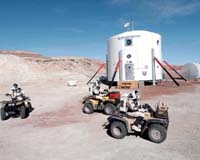 |
Bonn, Germany (SPX) Jan 24, 2011 During the last of a series of eight encounters with the martian moon Phobos, the High-Resolution Stereo Camera (HRSC) on ESA's Mars Express spacecraft acquired a detailed view of the martian satellite. The orbiter flew past Phobos at a distance of only 100 kilometres on 9 January 2011 and imaged the southern hemisphere of the irregularly-shaped moon. Researchers at the German Aerospace Center planned the image acquisitions, during which the orbiter was moving past Phobos at 2.3 kilometres per second, and processed the resulting data. Since Mars express flies in an elliptical orbit around the Red Planet, it regularly moves away from Mars and approaches Phobos, which orbits the planet at an altitude of roughly 6000 kilometres, about every five months. With data obtained during this flyby, the researchers were able to image large parts of the southern hemisphere of the moon for the first time at a resolution of 3.8 metres per pixel. HRSC scanned the martian moon, which is just over 20 kilometres across, with five of its nine sensors that are located sequentially in the camera. The sensors were active for a total of about a minute per sensor; Phobos was in the field of view for only nine seconds.
Craters, grooves and a boulder as big as a house For the computation of this complicated manoeuvre, the researchers considered the orbit of the moon and the exact path of the Mars Express orbiter, which ESA determines from a variety of parameters. Corrections during image acquisition were not possible as control signals transmitted from ground stations on Earth would have taken 19 minutes and 47.4 seconds to reach the spacecraft, but he manoeuvre was accomplished without any problems. However, "The maximum speed at which ESA could turn Mars Express during the flyby was 0.15 degrees per second. For ideal images, the spacecraft must be rotated at 0.26 degrees per second during the high-speed flyby," explained Matz. The effects caused by the limited slew rate were corrected later during processing. In the images, it is easy to see numerous craters and 'grooves' - markings whose origin is still undetermined. A boulder as big as a house discovered on the surface of Phobos casts a distinctive shadow. "With every Phobos image from the stereo camera, we can improve the three-dimensional model of the martian moon," says Prof. Jurgen Oberst of the DLR Institute of Planetary Research. "Most importantly, the new image data helps us to continuously improve the global image mosaic of the martian moon so that an atlas of Phobos can eventually be produced." Among other applications, the evaluation of the photographs is important for the Russian mission 'Phobos Grunt', which begins in November this year ('Grunt' is the transliteration of the Russian word for 'ground'). The mission includes plans for a lander to touch down on the martian moon, collect rock and dust samples with a robotic arm, and return them in a capsule to Earth. The lander will then spend a year on the surface of Phobos, performing scientific measurements in the martian environment.
HRSC The camera was developed at the German Aerospace Center (DLR) under the leadership of the PI, G. Neukum, and built in cooperation with industrial partners (EADS Astrium, Lewicki Microelectronic GmbH and Jena-Optronik GmbH). The experiment on Mars Express is operated by the DLR Institute of Planetary Research, through ESA/ESOC. The systematic processing of the HRSC image data is carried out at DLR. The scenes shown here were processed by the PI-group at the Institute for Geosciences of the Freie Universitat Berlin in cooperation with the DLR Institute of Planetary Research, Berlin.
Share This Article With Planet Earth
Related Links ESA Mars Express Mars News and Information at MarsDaily.com Lunar Dreams and more
 Mars Desert Research Station 2011 Field Season Begins
Mars Desert Research Station 2011 Field Season BeginsWashington DC (SPX) Jan 17, 2011 Mars Desert Research Station Crew 97 Summary Report - Crew 97 is a diverse team composed of various backgrounds and skill-sets which blend together to perform research at the Mars Desert Research Station (MDRS) for the purpose of enhancement of knowledge for future missions to Mars. As the crew was assigned by Mission Support, MDRS was their initial personal interaction. The crew developed ... read more |
|
| The content herein, unless otherwise known to be public domain, are Copyright 1995-2010 - SpaceDaily. AFP and UPI Wire Stories are copyright Agence France-Presse and United Press International. ESA Portal Reports are copyright European Space Agency. All NASA sourced material is public domain. Additional copyrights may apply in whole or part to other bona fide parties. Advertising does not imply endorsement,agreement or approval of any opinions, statements or information provided by SpaceDaily on any Web page published or hosted by SpaceDaily. Privacy Statement |